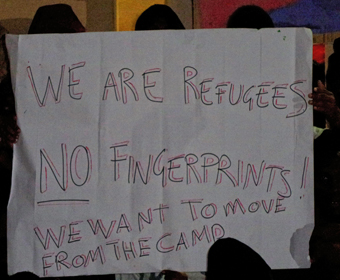di MARIA ROSARIA MARELLA
Segnaliamo nel n.2 (2023) di feminists@law un importante e utilissimo dossier dedicato alla riproduzione sociale, a cura di ENRICA RIGO e DONATELLA ALESSANDRINI (qui l’introduzione: Introduction: Social Reproduction and the Challenge to Legal Studies). Le curatrici annotano in apertura – e ci sembrano parole da sottoscrivere pienamente – che “la discussione sulla riproduzione sociale ha avuto un impatto limitato sul diritto e sugli studi giuridici. Con poche ma significative eccezioni, la dottrina giuridica ha quasi del tutto ignorato la categoria della riproduzione sociale o, tutt’al più, l’ha relegata a campi di interesse settoriali e femminizzati. Allo stesso tempo, quando i politici affrontano questioni come il lavoro non retribuito delle donne, il divario e il deficit di assistenza o la divisione sessuale del lavoro, i risultati raramente mettono in discussione le strutture legali e politiche dei processi di riproduzione sociale esistenti. Eppure, lungi dall’essere un campo di disputa meramente teorico, la riproduzione sociale è stata al centro delle lotte e delle rivendicazioni femministe che vanno dalla sicurezza del reddito alla necessità di ripensare le istituzioni di welfare, le relazioni di cura, così come l’intreccio tra città e scale ambientali.” Dal dossier riprendiamo qui l’intervento di Maria Rosaria Marella, incentrato sul modo attraverso cui il modello giuridico di lavoro familiare non pagato, così com’è strutturato dal diritto di famiglia, condiziona l’intera percezione della riproduzione sociale. E indicando qualche prospettiva di uso del diritto per supportare le lotte che intendono rompere l’egemonia storica e patriarcale del lavoro familiare non pagato. Ricordiamo che a riproduzione sociale e produzione di soggettività sarà dedicato uno dei prossimi percorsi seminariali di Euronomade.
Introduction
The law is a specific artifact that constructs relations of power and identities for both individuals and groups in society. In a few words, the law is constitutive of social reality. As such, it is also constitutive of the major symbolic and economic structure in the architecture of our societies known as the production/reproduction dichotomy. However, paradoxically, the crucial role of social reproduction in the functioning of societal dynamics appears to be overlooked in the legal realm: it is not even conceived as a legal issue, so much so that the very definition of social reproduction seems foreign to jurists’ vocabulary.
My argument in this paper is that the law has a critical impact on structuring the subalternity of social reproduction. Namely that the hierarchical order in the production/reproduction relation depends on the marginality of the legal field to which the legal recognition of social reproduction is entrusted: family law. In particular, I claim that the way in which family law constructs the core of reproductive labor, i.e. care and housework performed for free for spouse, children, elderly parents, disabled members of the family and the like, represents the matrix of the inequalities that arise from the marginalisation of social reproduction in the public discourse.
This paper aims to bring this legal pattern into the discussion with its ambiguities and the multiple implications it entails with reference to several aspects of social reproduction. In particular, I wish to shed light on the influence played by family law not just on informal (unpaid) care work but also on the commodification of care in general and the impact of all this on social reproduction at large. In doing so I will rely on the traditional toolbox set up by the Critical Legal Studies school of thought (Kennedy and Blalock, 2022), namely on 1. law’s inaction; 2. dichotomies’ deconstruction; 3. background rules and 4. legal setting’s incoherence.
Care work: is it a legal issue at all?
As a middle class straight white European married woman with 3 children and a 93 year old mother, I know clearly enough what care giving, especially in countries of the Global North, is about. Care giving is and has always been a fundamental structure in societies, although neglected by the production/reproduction divide ruling our perception of and approach to social organisation at large. Care work is in fact a crucial component of social reproduction, mostly privatised. We all have experienced the importance and pervasiveness of care – both in its menial and emotional aspects – during the confinement due to Covid-19. Probably many of us have taken the care – performed or received – for granted. Actually, care work is still mostly perceived as natural and prelegal. It is also assumed as natural – and irrelevant to the law – that care work is mostly performed by women.
A completely different approach to care work can be drawn from the following anecdote, ironically named A woman’s world (Fischl, 2004). In a dystopian (or utopian!) world, care work is socialised in care centers funded by the state, which are also sources of long-term employment preferentially offered to women. On the contrary, in such a dystopian (or utopian) world, safety services like police and fire protection are not provided by the state but privatised and allocated to families. Men are traditionally in charge of safety services which are unpaid and taken for granted by both society and family members. In this world, women are the breadwinners and men the ‘stay at home’ spouse. As a consequence, men are the ‘weaker spouse’, marginalised in the public sphere and subject to diminishing stereotypes and harassing behaviors in the workplace and the market. This tale shows that there is nothing natural in care work just like there is nothing natural in the privatised safety services like fire protection in the flipped world. And nothing natural also in the sexual division of labor. So, what’s the law got to do with it?
Drawing on Hohfeld’s account of law’s inaction (Hohfeld, 1916) and Hale’s critique of the liberal state (Hale, 1923), critical legal theory shows us that what apparently lies outside the law – i.e. those social facts seemingly unregulated, ignored by the law – is actually legally ruled by subtraction or surreptitiously regulated for the very fact that it is excluded from a certain legal setting. Exclusion from formal legal regimes is actually an option available to the legal system itself; nothing neutral or natural or non-legal, but on the contrary the outcome of a determination of legal policy. This is the case of the housework performed for spouses, children, elderly parents, disabled members of the family and the like: its apparent irrelevance to the law veils the legal construction of care work as unpaid work and even as non-work. It is a precise choice made by the legal system to assess care work as a fundamental tenet of marriage, grounded in love, affection and solidarity, and as such deprived of economic value. This is the cornerstone of a complex legal apparatus which grounds the production/reproduction divide.
Deconstructing the Production/Reproduction Divide: The Role of the Family/Market Opposition
My point is that the legal model of unpaid family work is hegemonic in the domain of social reproduction. It influences the social perception and the economy of the care work available in the market, as well as several other aspects of social reproduction. This is why hereinafter I will focus on unpaid family care work. The idea is that some kind of legal change – contractualisation of family care perhaps? – may help empowering family members who are the main caregivers, or redistribute homemaking within the family, and in so doing triggering a welcomed snowball effect throughout the whole domain of reproduction. In other words: it may help undoing gender.
However, legal change in the field can happen only once the production/reproduction dichotomy has been overcome. Critical theories of various origins and orientations, especially feminisms, have denounced the inherent ideological character of dichotomies as a mode of reporting, concealing, and reproducing inequalities and hierarchies within society.
Materialist feminism in the 70s worked on the deconstruction of the production/reproduction divide, showing that reproduction is economically productive just like production itself, because it reproduces the labor force, so that the reciprocal implication of both the terms of the opposition is at the basis of the primary functioning of capitalism. This is what I would call Deconstruction 1.0!
Nowadays, with the profound transformation of labor and labor markets, it is to be maintained that production and reproduction are not in opposition, rather they are in a continuum because of the penetration of the market rationale into the realm of reproduction (Kotiswaran, 2023), on the one hand, and, the tendency of so-called cognitive capitalist production to mimic modes and features typical of reproduction (Morini, 2010), on the other: Deconstruction 2.0. A third deconstructive strategy of the production/reproduction dichotomy has beenprovided starting from the 80’s (Olsen 1983) on the terrain of legal thought by the fem-crits movement, a strand of feminist legal theory active within the broader movement of Critical Legal Studies. An important stream of critical analysis developed by fem-crits focuses on the deconstruction of the family/market divide rooted in modern law since Savigny’s System (Savigny, 1886; Kennedy, 2010). This dichotomy is armed with a countervailing set of legal paradigms: the market is regulated by individualism, freedom of contract, personal autonomy, etc. whereas the family is ruled by solidarity, personal statuses, interdependence among its members, etc. The former plays the role of general law, while the latter is an exceptional and peripheral part of the system.
Many historical and political reasons explain and support the disciplinary power of the family/market dichotomy (Halley, 2011). To be sure, it provides the legal infrastructure for the opposition between reproduction and production to operate in our societies, and it legally grounds the sexual division of labor and the multiple gender hierarchies and inequalities that affect capitalist systems. It is no wonder that critical feminist jurists have identified the deconstruction of the dichotomy as the main target of their analysis, which aims to demonstrate that the law of the market and the law of the family are indeed informed by the same rationales, beyond the deep ideological difference attached to them (Olsen, 1983). Demystifying family law exceptionalism, demarginalising family law within private law, has been and continues to be at the core of the efforts of feminist legal theorists (Marella, 2006, 2018; Halley and Rittich, 2010). But the opposition keeps on ruling mainstream scholarship and law enforcement. As a matter of fact, family law exceptionalism shapes the legal treatment of informal care work. Although legal reforms in family law across the West after World War II, embracing the egalitarian family model, mark a shift towards the market rationale, care work does not share the same fate. Rather, it partially relinquishes its status as a natural and pre-legal phenomenon to be legalised among the essentials of marriage. Indeed, modern family law regulates caregiving as a marital duty of contribution to the household. But for the same reason it cannot be waived, nor can it be contractualised: in other words, it cannot be bargained for or paid for.In the end, it is essentially and legally unpaid work; construed, more precisely, as non-work.
Essentially, care work as a legal issue is shaped within and by family law. Its relevance emerges in various places in the law of marriage: 1. As an essential part of marriage, it represents a duty to contribute to the household; 2. It is rewarded by joint marital property in legal systems that enforce this regime model (but opting out usually requires no justification, so it’s quite easy to waive the default regime); 3. In the event of family breakdown, care work performed during marriage can be rewarded through alimony or division of marital property (with many limitations, depending on the balancing considerations of the courts as to whether and how much alimony is due, whether it is permanent or temporary, whether it rewards so-called investments in human capital or not, whether it is valued on the basis of living standards during marriage or on opportunity costs, or on the idea of individual autonomy and self-determination and marriage as a temporary partnership). In Italian law, an exception to the non-work standard is provided by the legal regime of the family business, which equates the work done for the business with the reproductive work done by family members, but this is a special rule that cannot be extended by analogy to other types of domestic joint enterprises.
If modern family law, like the rest of private law, moves from status to contract, the law of care work, on the contrary, remains at the margins of the process of family privatisation, since it is excluded from any form of contractualisation, unlike other aspects of family relations and the household, which are now infiltrated by the ius commune, i.e. the law of the market. The legal treatment of care work still and always is the epitome of family exceptionalism. I would define it as the tolerated residuum of patriarchy (Kennedy, 1992) in modern family law.
The non-work model as background rule
In keeping with this regulatory framework, legal discourse obscures the performative and gendered nature of unpaid care work: in divorce cases, lawyers typically talk about the weaker spouse and never link this weakness to unpaid care work for the family. According to this narrative, the weaker spouse is such by nature, not because she performs unpaid work for the family. Now, the conjugal regime of care work that I have just described does not only affect the power relations within married couples, nor does it exert its influence also in relation to unmarried couples (a different paradigm for them is hardly recognised), but it represents a (set of) background rule(s) that affects the whole law of social reproduction, influencing the bargaining power of caregivers and defining the position of women in society and the market. In fact, on the one hand, the non-work model established by family law influences the availability and desirability of alternative options that informal caregivers can find in the market, to the extent that the burden of care work renders them structurally less appealing in the marketplace and weak in bargaining; on the other hand, this same weakness affects the possibility and desirability of leaving marriage to pursue an independent life.
All the consequences I have just listed also play out at the symbolic level. First, being the predominant or exclusive provider of care work creates a presumption of willingness to cooperate as a social actor. Women are therefore perceived as presumably inclined to cooperate. And since the household is a woman’s domain, solidarity is the main attitude of women, both in the family and in the market. Second, this social stereotype extends far beyond family law, domesticity and the sphere of informal care work, insofar as it contributes to the production of subaltern subjectivities and to the creation/reinforcement of a non-market sphere with specific characteristics: unregulated activities, womanly labor, unskilled work, social isolation (Kotiswaran, 2023). Third, this complex pattern directly and indirectly affects the way waged care work is socially perceived. The commodification of care (waged care work) is generated by the desire of women in the Global North to be freed from the unpaid gendered care work in the family that makes them economically vulnerable and socially marginal. The reverse is also true: global care chains with migrant care workers (mostly women) from the Global South working in households in the Global North affect family relations and the distribution of unpaid care work itself, both at the beginning of the chain (in the household of the migrant care worker, whose housework is now to be done by an older daughter or a local paid care worker) and at the end of the global care chain (the household of the employer).
Paid and unpaid care work are mutually constitutive and share the same social perception, the two polarities of which are romanticisation on the one hand and devaluation on the other. Both the romanticisation and the devaluation of care derive from commonplaces about unpaid family work, which in turn are grounded in its legal regime: women’s ethics of care, women’s presumed inclination to cooperate, are reflected in the legal construction of housework as non-work. Even the feminist debate on the commodification of care is deeply influenced by the main features of family homemaking: for example, both the main downsides of commodified care (such as precariousness, low wages, social isolation, etc.), and the question of the emotional economy of care that inform the debate on global care chains (What exactly is care? How much love and affection is involved? Is love extinguished by money? And how real is work that involves love and human compassion?) result directly or indirectly from the way in which the law conceptualises unpaid work within the family.
To sum up, the model of unpaid family work exerts a symbolic hegemony in the field of social reproduction, since it influences the social perception and the economy of care and reproductive work available in the market. It also acts as a background rule that affects the bargaining power of caregivers in whatever employment or social activity they undertake, disempowering them.
Conclusion
For the time being,the shadow of patriarchy keeps onlooming over; the unequal distribution of unpaid family care work between genders has not significantly changed in households with waged caregivers: the employer-employee relationship is basically between women, and the traditional family model continues to shape familial relations in terms of care work distribution. Gender role patterns according to which women are responsible for care giving (menial and emotional) are not broken. The significant change is that the physical burden of care is redistributed among women of different classes and ethnicities freeing the better-off to compete in the labor market. How to get out of this trap?
Family law regimes governing caregiving are largely incoherent. On the one hand, caregiving, as an essential of marriage, is a binding obligation; on the other hand, its natural reward is to be found in joint marital property regimes, which can be, and usually are, opted out. Similarly, marital property regimes in the event of family breakdown – alimony upon divorce and the division of marital property – are enforced within a framework marked by a strong production/reproduction divide that collides with a full recognition of the economic value of care work performed during marriage. But, at the same time, prenuptial agreements – if they are not struck down as against public policy – can hardly consider and quantify the compensation for care to be provided within marriage because the dominant idea of care as non-work, or as an obligation, is at odds with its contractualisation.
In this scenario it happens that the disregard for the economic value of care suddenly disappears when the informal caregiver is injured by a third party. In this case, her family members recover damages for the loss of domestic work: what is denied in the home is recognised as a family asset and protected from third parties. At the end of the day, the system of structural gender inequality generated by caregiving is due to the mix of ideology and incoherence that underlies such a paradoxical regime. Can its commodification/contractualisation be the solution? Can these processes change the social perception of care work? Can a possible way out come from breaking down the family law wall that produces and reproduces the unpaid work=non-work pattern? A change in the background rules is absolutely necessary. The availability of such domestic contracts would be a way to overcome the exceptionalism of family law and the related legal narrative of care work: through negotiation, care work emerges as a legal issue in the context of a family/market merger. Changing the background rules would have a significant distributive impact … although initially limited by the snowball effect due to the material and symbolic power of the non-work model. The recognition of care as a family asset would help to overcome the contradictions inherent in the current system. Of course, this perspective is not all sunshine and rainbows. Imbalances in the bargaining power of family members, technical problems related to the legal enforceability of such contracts, and difficulties in setting wages for family care are major hurdles along the way. But they are not insurmountable. To be sure, bargaining in the shadow of a new law may offer a chance that bargaining in the shadow of patriarchy denies.
References
Fischl, Richard M. A Woman’s World: What if care work were socialized and police and fire protection left to individual families?, 52 Buff. L. Rev. 659 (2004);
Hale, Robert L., Coercion and Distribution in a Supposedly Non-Coercive State, 38:3 Political Science Quarterly 470–94 (1923);
Halley, Janet, What is Family Law? A Genealogy Part I and Part II, 23 Yale J. L. & Human. 1, 189 (2011);
Halley, Janet and Rittich, Kerry, Critical Directions in Comparative Family Law: Genealogies and Contemporary Studies of Family Law Exceptionalism, 58:4 The American Journal of Comparative Law, 753–775 (2010);
Hohfeld, W.N.. Fundamental legal conceptions as applied in judicial reasoning, 26:16 Yale Law Journal, 710-770 (1916);
Kennedy, Duncan and Blalock, Corinne, Provocation as Strategy: An Interview with Duncan Kennedy (March 17, 2023), 121:2 The South Atlantic Quarterly 377 (2022);
Kennedy, Duncan, Savigny’s Family/Patrimony Distinction and its Place in the Global Genealogy of Classical Legal Thought, 58 Am. J. Comp. L. 811 (2010);
Kennedy, Duncan, Sexual Abuse, Sexy Dressing, and the Eroticization of Domination, New England Law Rev (1992);
Kotiswaran, Prabha, Social Reproduction Feminism and the Law: Ships in the Night passing each other, 12:2 feminists@law (2023);
Marella, Maria R. 2018, Family-Relations Law between ‘Stratification’ and ‘Resistance’. Housework and Family Law Exceptionalism, in Sarti, Bellavitis, Martini (eds.), What is Work. Gender at the Crossroads of Home, Family, and Business from the Early Modern Era to the Present, Berghahn Books, Oxford, New York;
Marella, Maria R., 2006, The Non-Subversive Function of European Private Law: The Case of Harmonization of Family Law, in 12 European Law Journal, 78 -105;
Morini, Cristina. Per amore o per forza. Femminilizzazione del lavoro e biopolitiche del corpo. Ombre corte: Verona, 2010;
Olsen, Frances E. The Family and the Market: A Study of Ideology and Legal Reform. 96:7 Harvard Law Review1497–578 (1983);
Savigny, Carl von, 1840-49, System des heutigen römischen Rechts, trad. it. di V. Scialoja, Sistema del diritto romano attuale, Torino, 1886.

















